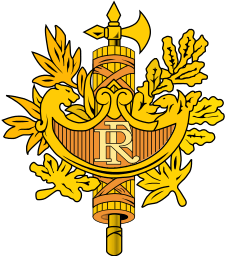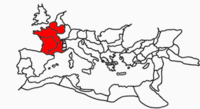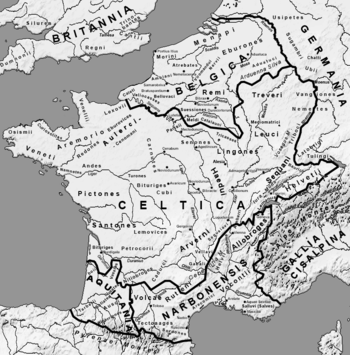Roman Gaul
Part of a series on the |
||||||||||||||||||||||||||||||
|---|---|---|---|---|---|---|---|---|---|---|---|---|---|---|---|---|---|---|---|---|---|---|---|---|---|---|---|---|---|---|
| History of France | ||||||||||||||||||||||||||||||
.svg.png)   | ||||||||||||||||||||||||||||||
|
||||||||||||||||||||||||||||||
|
||||||||||||||||||||||||||||||
|
||||||||||||||||||||||||||||||
|
||||||||||||||||||||||||||||||
|
||||||||||||||||||||||||||||||
|
||||||||||||||||||||||||||||||
| France portal | ||||||||||||||||||||||||||||||
Roman Gaul consisted of an area of provincial rule in the Roman Empire, in modern-day France, southern Netherlands, Belgium, Luxembourg, western Switzerland and western Germany. Roman control of the area lasted for more than approximately 500 years.
The Roman Republic began its takeover of Celtic Gaul in 121 BC, when it conquered and annexed the southern reaches of the area. Julius Caesar completed the task by defeating the Celtic tribes in the Gallic Wars of 58-51 BC. The Gaulish language became extinct from the fifth century AD onwards.
The last vestige of Roman rule was effaced by the Franks at the Battle of Soissons (486); displacing the Visigothic kingdom of Toulouse in 507 A.D.
The city of Lugdunum (now Lyon) had long been the capital of Gaul.
Geographical divisions
Gaul had three geographical divisions, one of which was divided into multiple Roman provinces:
- Gallia Cisalpina or "Gaul this side of the Alps", covered most of present-day northern Italy.
- Gallia Narbonensis, formerly Gallia Transalpina or "Gaul across the Alps" was originally conquered and annexed in 121 BC in an attempt to solidify communications between Rome and the Iberian peninsula. It comprised the present-day region of Provence-Alpes-Côte d'Azur, most of Languedoc-Roussillon, and roughly the southeastern half of Rhône-Alpes.
- Gallia Comata, or "long haired Gaul", encompassed the remainder of present-day France, Belgium, and westernmost Germany, which the Romans gained through the victory over the Celts in the Gallic Wars. The Romans divided Gallia Comata into three provinces:
The Romans divided these huge provinces into civitates corresponding more or less with the pre-Conquest communities or polities sometimes described misleadingly as "tribes," such as the Aedui, Allobroges, Bellovaci, and Sequani (see List of Celtic tribes) but the civitates were too large and in turn were divided into smaller units, pagi, a term that eventually became the modern French word "pays".[1] These administrative groupings would be taken over by the Romans in their system of local control, and these civitates would also be the basis of France's eventual division into ecclesiastical bishoprics and dioceses, which would remain in place—with slight changes—until the French revolution.
-

Gaul in the Roman Empire
-

Map of Gaul circa 58 BC
Language and culture

In the five centuries between Caesar's conquest and the collapse of the Western Roman Empire, the Gaulish language and cultural identity underwent a syncretism with the Roman culture of the new governing class, and evolved into a hybrid Gallo-Roman culture that eventually permeated all levels of society. Gauls continued writing some inscriptions in the Gaulish language, but switched from the Greek alphabet to the Latin alphabet during the Roman period. Current historical research suggests that Roman Gaul was "Roman" only in certain (albeit major) social contexts, the prominence of which in material culture has hindered a better historical understanding of the permanence of many Celtic elements. The Roman influence was most apparent in the areas of civic religion and administration. The Druidic religion was suppressed by Emperor Claudius I, and in later centuries Christianity was introduced. The prohibition of Druids and the syncretic nature of the Roman religion led to disappearance of the Celtic religion. It remains to this day poorly understood: current knowledge of the Celtic religion is based on archeology and via literary sources from several isolated areas such as Ireland and Wales.
The Romans easily imposed their administrative, economic, artistic (especially in terms of monumental art and architecture) and literary culture. They wore the Roman tunic instead of their traditional clothing. The Romano-Gauls generally lived in the vici, small villages similar to those in Italy, or in villae, for the richest.

Surviving Celtic influences also infiltrated back into the Roman Imperial culture in the 3rd century. For example, the Gaulish tunic—which gave Emperor Caracalla his surname—had not been replaced by Roman fashion. Similarly, certain Gaulish artisan techniques, such as the barrel (more durable than the Roman amphora) and chain mail were adopted by the Romans.
The Celtic heritage also continued in the spoken language (see History of French). Gaulish spelling and pronunciation of Latin are apparent in several 5th century poets and transcribers of popular farces.[2] The last pockets of Gaulish speakers appear to have lingered until the 6th or 7th century.
Germanic placenames were first attested in border areas settled by Germanic colonizers (with Roman approval). From the 4th to 5th centuries, the Franks settled in northern France and Belgium, the Alemanni in Alsace and Switzerland, and the Burgundians in Savoie.
After the fall of Rome
The Roman administration finally collapsed as remaining troops were withdrawn southeast to protect Italy. Between 455 and 476 the Visigoths, the Burgundians, and the Franks assumed power in Gaul. However, certain aspects of the ancient Celtic culture continued after the fall of Roman administration and there was a remnant of the Empire for ten more years.
In 486, Gaul ceased to be a Roman state by the Franks at the Battle of Soissons. Almost immediately afterwards, Gaul came under the rule of the Merovingians, the first kings of France.
Certain Gallo-Roman aristocratic families continued to exert power in episcopal cities (as in the cases of the Mauronitus family in Marseilles and Bishop Gregory of Tours). The appearance of Germanic given and family names becomes noticeable in France from the middle of the 7th century on, most notably in powerful families, thus indicating that the centre of gravity had definitely shifted.
The Gallo-Roman, or Vulgar Latin, dialect of the late Roman period evolved into the dialects of the Oïl languages and Old French in the north, and Occitan in the south.
Gallia and its equivalents continued to be used, at least in writing, until the end of the Merovingian period. Slowly, during the Carolingian period, the expression Francia, then Francia occidentalis spread to describe the political reality of the kingdom of the Franks (regnum francorum).
See also
- Asterix, French comic set in 50 BC Gaul
- Roman Britain's continental trade
Notes
References
- Portions of this article are based on a translation of the article Gaule from the French Wikipedia on February 2007.
External links
| Wikimedia Commons has media related to Roman Gaul. |
- Romans in Gaul : A Webliography - A Teacher Workshop held at Temple University, November 3, 2001. Dr. Janice Siegel, Department of Classics, Hampden-Sydney College, Virginia
| ||||||
| ||||||||||||||||||||||||||||||||||||||||||||